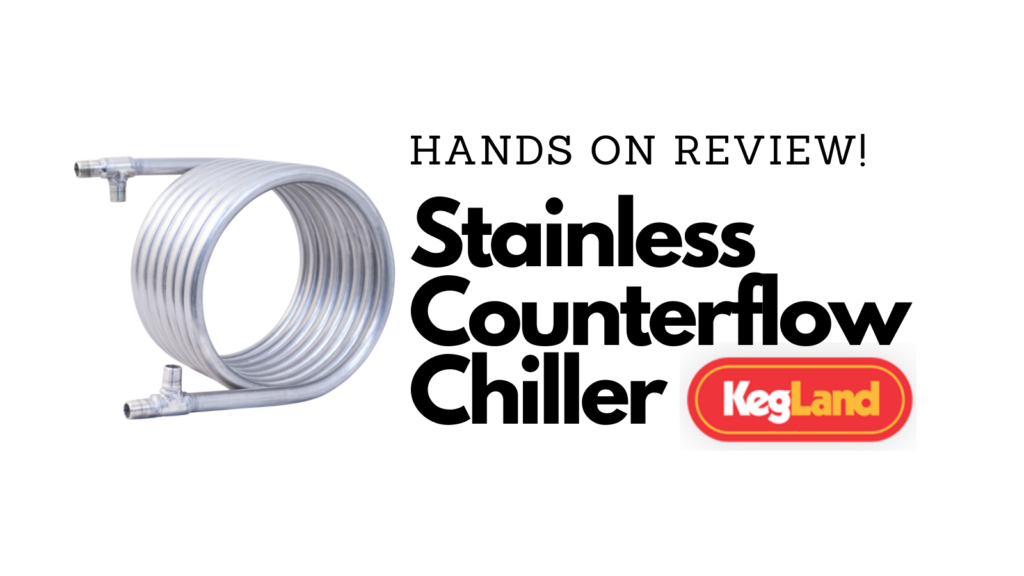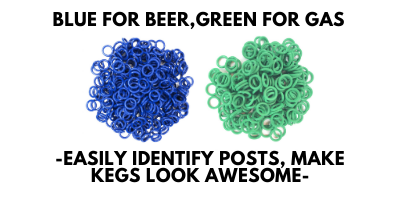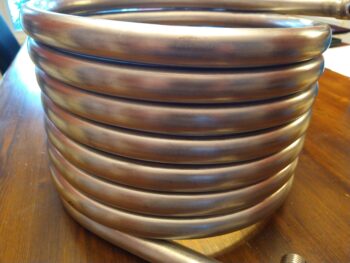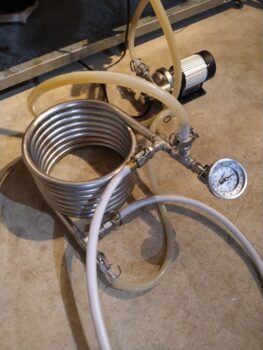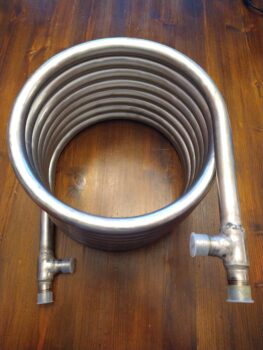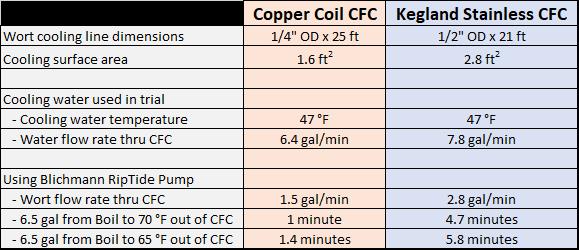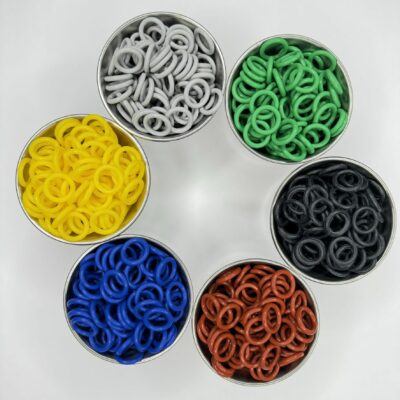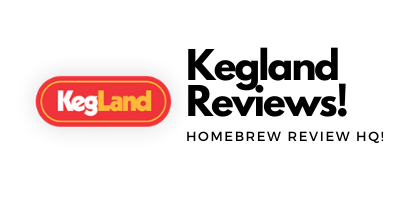
Hands on Review: Kegland Coolosus Stainless Steel Counterflow Chiller!
This review is by Homebrew Finds Contributor Brad Probert. Brad is an engineer, expert homebrewer and experienced reviewer. Grab a link to Brad’s website at the end of this review.
Kegland Stainless Counterflow Chiller
In the past, I did some trials on the different types of wort chillers, and ended up with a counterflow chiller as the best solution for me. Of course, it depends on what you are prioritizing as a feature. Plate chillers are the fastest, but after I had a clogging incident, I had no confidence I could ever get it 100% clean again. Immersion chillers (even fancy ones) were slower, but most notably, they required me to continually bob them up and down in order to really be effective. The counterflow chiller is fast, and the relatively large passageways mean you don’t have to worry about debris clogging them up.
Check Current Price & Availability, Review Continues Below:
- Coolossus Counterflow Chiller
- Also available in a tri-clamp version! Coolossus Gen 2 Tri Clamp Counterflow Chiller
Here’s how a Counter Flow Chiller (CFC) works. You wort flows inside a smaller diameter tube, which sits inside a larger diameter tube that’s filled with your cooling water. Heat gets drawn out of the wort through the conductive walls of the inner tube (made of heat-conductive metal like copper or stainless steel). To keep the package size compact, these very long lengths of tubing get coiled up on top of each other like a snake. And there are 4 connections- wort in, wort out, cooling water in, cooling water out.
This article contains affiliate links. We may make a small percentage if you use our links to make a purchase. You won’t pay more and you’ll be supporting Homebrew Finds and more content like this. Thank you for your support!
The “counter flow” piece is some ingenious engineering where the coldest water goes in at the same end as you have the cooler wort coming out. As the cooling water flows through the chiller, it’s picking up heat from the wort, and that makes the cooling water warmer. Since heat transfer is proportional to the temperature difference between your wort and the cooling water, the counterflow sets you up for a temperature difference the whole way through your chiller. The coldest water is next to your coolest wort, so there’s still a temperature difference and still some heat taken out of the wort. And the cooling water that picks up heat all the way through the chiller, is still cooler than the hot wort coming directly from the kettle.
Within the world of CFCs, there are a lot of factors that change from one design to the next. The longer the length of your CFC, the more surface area you have in contact between the wort and cooling water as it flows along. But that also makes it more restrictive to flow, and if you’re trying to recirculate into your kettle to make a whirlpool, long CFCs have an effect on that. The thermal conductivity of copper is much better than stainless steel, but there are those that want to avoid copper in their brewing for various reasons. And special shape wort tubing might get more contact area for your wort to the cooling water, but nooks and crannies lead to low flow rates that can catch and accumulate debris that are hard to clean.
Hands on Review
The Kegland Stainless CFC from MoreBeer is bright and shiny. That’s obvious when you see it online, and is no different when you see it in person. The overall form factor is easy to work with, with smooth, rounded edges, and you can easily just grab it from the middle and move it around the brewery. I added on a MoreBeer dial thermometer, and teed it in to the output wort flow. With the adjustable face on this thermometer, I could put the chiller on the floor, but have the face angled up so I could read it. The gauge needle was very steady and the numbers were easily readable. Being able to monitor the temperature of outflowing wort let me know when it was time to stop recirculating flow and starts pumping wort into the fermentor. It also helped dial in hopstand temperature, as I could monitor bulk temperature in the kettle I was trying to get to 170F, and modulate cooling water flow rate for the cooled wort I was recirculating back in.
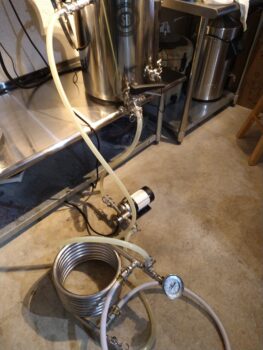 Recirculating Wort During Hopstand
Recirculating Wort During Hopstand
The CFC had two features that had an odd location. First was the fact that two of the fittings I had to attach my lines to were on the very bottom, sitting on the floor. As I was using camlock fittings, I had to arrange it so the locking lever didn’t get in the way as it sat on the brewery floor. This didn’t cause any problems, it just seemed a bit strange to have the fittings sitting directly on the floor. The other odd positioning was the cooling water inlet/outlet ports. Those were pointed inward which made it nice and tidy and kept me from getting snagged on stuff as I stashed it on a shelf in between brew days. But they did make things a bit cluttered when both water cooling hoses were pointing in towards each other when in use.
The 1/2″ male threads were BSP standard, not NPT. These two pipe standards are similar but not exact. As a result, you can get North American NPT fittings to screw on to the BSP threads, but it takes extra Teflon tape wraps to prevent them from leaking. I normally do 3 wraps, but it wept, so I had to do 1 or 2 more to get it leak-free. But once I did, I had no leak issues through several brew sessions I’ve done since. The welds weren’t particularly pretty, but I had no leaks. I used ProFlow Dynamics camlock fittings for almost everything.
Related Review:
With the stainless steel exterior, it gets hot to the touch quickly. I learned the hard way to make sure I hooked up my cooling water lines before starting to recirculate hot wort to sanitize the CFC. Since heat conduction goes both ways, in theory you could take advantage of this to “turbo charge” your wort cooling. If you were to get an ice chest, you could fill it with ice water and just stick the whole CFC in there. No need for a separate pre-chiller series connection, it could just sit in the ice water and help keep cooling water temperatures lower. I didn’t try this during my trials because my ground water was already cool enough, but thought it worth mentioning if you brew in an area that has “not so cool” ground water in the summertime.
I collected some data on flow rates and cooling times. Comparing to my other CFC, I noticed a difference in cooling time, but also a difference in recirculation flow rate. A faster flow rate due to less restriction meant the whirlpool attachment in my kettle was more effective at rounding up hop debris in the center, and meant a faster fill of the fermentor once the wort was cooled. However, that faster flow rate meant less contact time with the cooling water and took longer to get to a lower wort temperature out of the CFC. So as with everything, there are trade-offs, and you need to think about what’s important to you. Being the fastest sounds nice, but how fast is fast enough? And is recirculation flow rate important to you? I summarized the data from my trials in this chart.
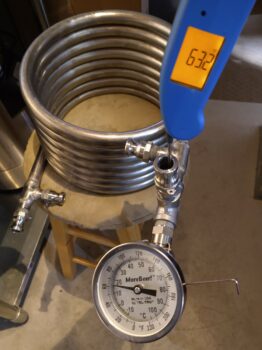 Calibrating Thermometer using Thermapen – Hands on Review
Calibrating Thermometer using Thermapen – Hands on Review
Conclusions
Overall, the Kegland Stainless Steel Counterflow Chiller worked really well for me. I didn’t realize what I was missing with a less restrictive wort flow path to improve aspects of my brewing gear. And although not as fast as my other CFC, it was still plenty fast enough for me. After reading more about standing water and copper, I prefer the thought of all those passageways inside I can’t see being stainless steel. I definitely recommend the dial temperature gauge on the output, to really make best use of your CFC, as well.
Check Current Price & Availability, More PHOTOS Below:
- Coolossus Counterflow Chiller
- Also available in a tri-clamp version! Coolossus Gen 2 Tri Clamp Counterflow Chiller
More Photos
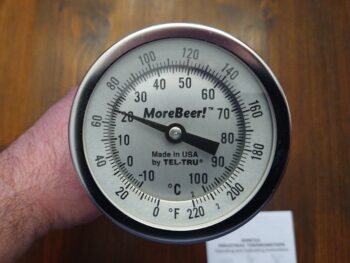 MoreBeer Dial Thermometer
MoreBeer Dial Thermometer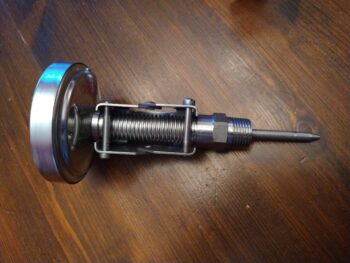 Adjustment Mechanism on Thermometer
Adjustment Mechanism on Thermometer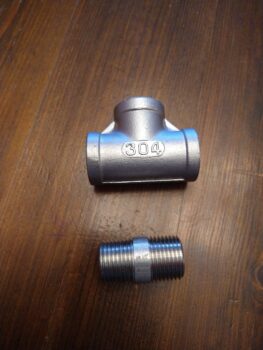 Stainless Tee
Stainless Tee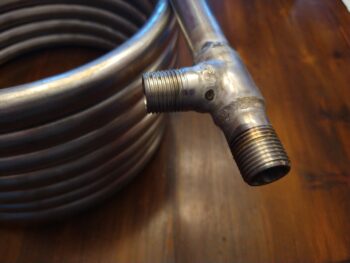 Welds to Cooling Channel Ugly but Leak-free
Welds to Cooling Channel Ugly but Leak-free
More Kegland Gear Reviews!
More Homebrew Finds!
- Last 50 Finds!
- Top Deals – a curated list of the best deals
- Homebrew Reviews – one of the largest libraries of homebrew reviews in existence!
- Our Top Posts – tips, how-tos, resources posts and more
- Let’s be Friends!
Recent Deals!
10 Most Recent Homebrew Resource Posts & How-To’s!
We are Homebrew Review HQ! Our 10 Most Recent Reviews
pinnedThis post may contain affiliate links. We may make a commission when you use our links. This will never cost you extra. Thank you for supporting Homebrew Finds!
greatdealsBy Brad Probert. Check out Brad’s website – beersnobby.com
Special Thanks to Kegland and MoreBeer for providing the unit used for evaluation in this review.
Price, promotions and availability can change quickly. Check the product page for current price, description and availability.
Make sure the components you use are compatible and rated for your intended application. Contact manufacturer with questions about suitability or a specific application. Always read and follow manufacturer directions. tag:lnksfxd review:klcfwch tag:tpr
